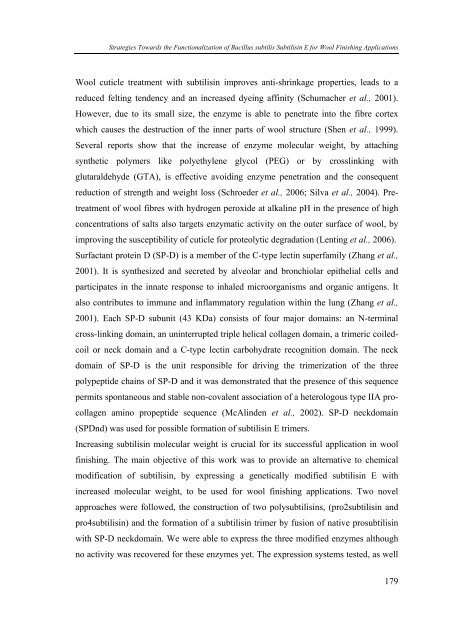Surface Modification of Cellulose Acetate with Cutinase and ...
Surface Modification of Cellulose Acetate with Cutinase and ...
Surface Modification of Cellulose Acetate with Cutinase and ...
Create successful ePaper yourself
Turn your PDF publications into a flip-book with our unique Google optimized e-Paper software.
Strategies Towards the Functionalization <strong>of</strong> Bacillus subtilis Subtilisin E for Wool Finishing Applications<br />
Wool cuticle treatment <strong>with</strong> subtilisin improves anti-shrinkage properties, leads to a<br />
reduced felting tendency <strong>and</strong> an increased dyeing affinity (Schumacher et al., 2001).<br />
However, due to its small size, the enzyme is able to penetrate into the fibre cortex<br />
which causes the destruction <strong>of</strong> the inner parts <strong>of</strong> wool structure (Shen et al., 1999).<br />
Several reports show that the increase <strong>of</strong> enzyme molecular weight, by attaching<br />
synthetic polymers like polyethylene glycol (PEG) or by crosslinking <strong>with</strong><br />
glutaraldehyde (GTA), is effective avoiding enzyme penetration <strong>and</strong> the consequent<br />
reduction <strong>of</strong> strength <strong>and</strong> weight loss (Schroeder et al., 2006; Silva et al., 2004). Pretreatment<br />
<strong>of</strong> wool fibres <strong>with</strong> hydrogen peroxide at alkaline pH in the presence <strong>of</strong> high<br />
concentrations <strong>of</strong> salts also targets enzymatic activity on the outer surface <strong>of</strong> wool, by<br />
improving the susceptibility <strong>of</strong> cuticle for proteolytic degradation (Lenting et al., 2006).<br />
Surfactant protein D (SP-D) is a member <strong>of</strong> the C-type lectin superfamily (Zhang et al.,<br />
2001). It is synthesized <strong>and</strong> secreted by alveolar <strong>and</strong> bronchiolar epithelial cells <strong>and</strong><br />
participates in the innate response to inhaled microorganisms <strong>and</strong> organic antigens. It<br />
also contributes to immune <strong>and</strong> inflammatory regulation <strong>with</strong>in the lung (Zhang et al.,<br />
2001). Each SP-D subunit (43 KDa) consists <strong>of</strong> four major domains: an N-terminal<br />
cross-linking domain, an uninterrupted triple helical collagen domain, a trimeric coiledcoil<br />
or neck domain <strong>and</strong> a C-type lectin carbohydrate recognition domain. The neck<br />
domain <strong>of</strong> SP-D is the unit responsible for driving the trimerization <strong>of</strong> the three<br />
polypeptide chains <strong>of</strong> SP-D <strong>and</strong> it was demonstrated that the presence <strong>of</strong> this sequence<br />
permits spontaneous <strong>and</strong> stable non-covalent association <strong>of</strong> a heterologous type IIA procollagen<br />
amino propeptide sequence (McAlinden et al., 2002). SP-D neckdomain<br />
(SPDnd) was used for possible formation <strong>of</strong> subtilisin E trimers.<br />
Increasing subtilisin molecular weight is crucial for its successful application in wool<br />
finishing. The main objective <strong>of</strong> this work was to provide an alternative to chemical<br />
modification <strong>of</strong> subtilisin, by expressing a genetically modified subtilisin E <strong>with</strong><br />
increased molecular weight, to be used for wool finishing applications. Two novel<br />
approaches were followed, the construction <strong>of</strong> two polysubtilisins, (pro2subtilisin <strong>and</strong><br />
pro4subtilisin) <strong>and</strong> the formation <strong>of</strong> a subtilisin trimer by fusion <strong>of</strong> native prosubtilisin<br />
<strong>with</strong> SP-D neckdomain. We were able to express the three modified enzymes although<br />
no activity was recovered for these enzymes yet. The expression systems tested, as well<br />
179

















